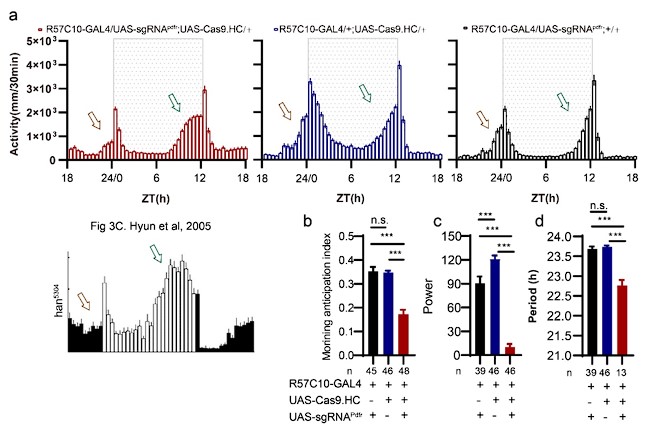Peer review process
Not revised: This Reviewed Preprint includes the authors’ original preprint (without revision), an eLife assessment, public reviews, and a provisional response from the authors.
Read more about eLife’s peer review process.Editors
- Reviewing EditorAmita SehgalUniversity of Pennsylvania, Philadelphia, United States of America
- Senior EditorK VijayRaghavanNational Centre for Biological Sciences, Tata Institute of Fundamental Research, Bangalore, India
Reviewer #1 (Public Review):
Summary:
The paper of Mao et al. expands the genetic toolset that was previously developed by the Rao lab (Denfg et al 2019) to introduce the conditional KO or downregulation of neurotransmission components in Drosophila. The authors then use these tools to investigate neurotransmission in the clock neurons of the Drosophila brain. They first test some known components and then analyze the contribution of the CNMa neuropeptide and its receptor to the circadian behavior. The results indicate that CNMA acts from a subset of DN1ps (dorsal clock neurons) to set the phase of the morning peak of locomotor activity in light:dark cycles, with an advanced morning activity in the absence of the neuropeptide. Interestingly, the receptor for the PDF neuropeptide appears to be acting in some of the CNMa neurons to control morning activity.
Strengths/weaknesses:
This is clearly a very useful new set of tools to restrict the manipulation of these components to specific neuronal populations, and overall (see specific points below), the paper is convincing to show that the tools indeed allow to efficiently and specifically eliminate neuropeptides/receptors from subsets of neurons. The analysis of the CNMa function in the clock network reveals a new and interesting function for CNMa. but this part needs to be improved. Some of the behavioral data (PDF/PDFR) do not fit with published work with the mutants. This should be clarified by providing more data comparing the described genotypes with the classical mutants. Some conclusions also need to be toned down.
Reviewer #2 (Public Review):
In this study, Mao and co-workers deliver a substantial suite of genetic tools in support of the senior author's recent proposal to create a "chemoconnectomic" tool kit for the expression mapping and conditional disruption of specific neurotransmitter systems with fly neurons of interest. Specifically, they describe the creation of two toolsets for recombination-based and CRISPR/Cas9-based conditional knockouts of genes supporting neurotransmitter and neuromodulator function and Flp-Out and Split-LexA toolkit for the examination of gene expression within defined subsets of neurons. The authors report the creation of conditional genetic tools for the disruption/mapping of approximately 200 chemoconnectomic gene products, an examination of the general effectiveness of these tools in the fly brain, and apply them to the circadian clock network in an attempt to reveal new information regarding the transmitter/modulator systems involved in daily behavioral timing. The authors provide clear evidence of the effectiveness of the new methods along with a transparent assessment of the variability of the tools. In addition, they present evidence that the neuro peptide CNMa influences the morning peak of daily activity in the fly by regulating the timing of activity increases in anticipation of dawn.
A major strength of the study is the transparent assessment of the effectiveness and variability of the conditional genetic approaches developed by the authors. The authors have largely achieved their aims and the study therefore represents a major delivery on the promise of chemoconnectomics made by the senior author in 2019 (Neuron, Vol. 101, p. 876). Though there are some concerns about the variability of knockout effectiveness, off-target effects of the knockout strategies, and (especially) the accuracy of the gene expression approach, the tools created for this study will almost certainly be useful for the field and support a great deal of future work.
Reviewer #3 (Public Review):
Summary:
Mao and colleagues generated powerful reagents to genetically analyse chemical communication (CCT) in the brain, and in the process uncovered a function for the CNMa neuropeptide expressed in a subset of DN1p neurons that contributes to the temporal organization of locomotor activity, i.e., the timing of morning anticipation.
Strengths:
The strength of the manuscript relies on the generation/characterization of new tools for conditional targeting a well-defined set of CCT genes along with the design and testing of improved versions of Cas9 for efficient knockout. Such invaluable resources will be of interest to the whole community. The authors employed these tools and intersectional genetics to provide an alternative profiling of clock neurons, which is complementary to the ones already published. Furthermore, they uncovered a role for CNMamide, expressed in two DN1ps, in the timing of morning anticipation.
Weaknesses:
They targeted an extensive set of candidate genes putatively involved in communication (transporters, receptor subunits, neuropeptides, neurotransmitter synthesis, etc); they provide a list of efficient gRNAs to target even a longer list of candidate genes, however, it is not clear if all of those made it into transgenic lines that effectively mediate targeting all chemical transmission genes (as suggested by the authors).




